Airport Trains Suck. Will REM Too?
May 26th, 2016 by ant6nThe Caisse’s REM proposal has given Montrealers hope to finally have a rail connection to the airport.
The problem with rail connectors to airports, however, is that they are generally not a very good use of money: they are often expensive and have low ridership. Airport connectors underperform.
Don’t get me wrong, I like the idea of taking a metro home from the airport. I think most people would love that too, which is why everyone is so excited about it. But even if everyone will use it at some point or another, most only go to the airport once or twice a year. Thus, on any given day, not many people will use it. And that means low ridership.
Comparison with airport connectors in other cities
How many people would use the new proposed airport connector? In their marketing material, the Caisse claims 10,000 people will use it every day. But they have refused to provide their ridership study to back up that claim.
Given that the airport express bus is currently used by about 3,000 people per day, is this increase in transit ridership credible? Or are they being overly optimistic?
Since the Caisse is not releasing their numbers, I made my own “studyâ€. Using a simple model, I have compared the ridership of North American airports with rail connections, to see what ridership could be like in Montreal. The assumption is that the proportion of people taking transit vs cabs or cars is similar across different airports. So if Montreal Trudeau is three times smaller than New York’s JFK, then the ridership of its transit line should be three times smaller as well.
To make results comparable to Montreal, the model includes airports with the following characteristics:
- they must be in North America, to have a similar relative use of cars and transit
- the rail connection must be the only major transit connection to the airport
- the rail connection must be frequent (every 15 minutes or better)
- the rail connection must provide a reasonable connection into town
The scatterplot below shows daily ridership of the rail connector vs annual number of passengers through the airport (data). Airports in the upper left have a lot of transit ridership relative to their size, and airports in the bottom right are doing really badly. Note that large hub airports airports will be under-represented using this heuristic, because more passengers transfer to other flights at the airport.
We see, first of all, that some airport connectors really do suck. In a whole day, they could barely fill a couple of trains. Most airport other connectors do ok, and bring in about 3K to 5K riders for every 15M airport passengers per year (i.e. the size of Montreal’s airport).
One airport does exceptionally well, and that’s Vancouver’s Canada Line. But it really is an outlier. It seems that the Caisse wants to create another such outlier with the REM, way beyond the 90% percentile. The ridership relative the total number of airport passengers for those two lines would be really far away from all other North American Airport connectors:
On the whole, their 10K estimate is not entirely outrageous, but leans on the optimistic side. Maybe a more conservative estimate (but still assuming we can do better than the average because transit use is generally higher in Montreal), would be 5,000 to 6,000 riders per day. Definitely one should be concerned that the Caisse is using too optimistic projections.
Lessons From Toronto
One airport-connector project that turned out to have overly optimistic projections is the Union Pearson Express in Toronto.
The Express was initially sold to the public with a projected ridership of 8,000/day during the opening year. After construction started, the number was revised down to 5,000 after the first year and only reaching 7,500/day by 2025!
And once it was built, the ridership was actually declining after a lethargic start, down to about 2,200 raiders per day, as most people were put off by the $27.50 fare. At that point the fare was slashed to $12 and ridership quickly increased to be in line with projections (~5000/day).
The Pearson Express was built at a cost of 456 million dollars. In absolute terms, this is pretty cheap for a transit line, and was made possible by running most of the Pearson Express on existing commuter rail tracks. However, considering that only 5000 people use it every day, that’s a cost of $91,200 per daily rider. In terms of cost/benefit, that turns out to be very expensive compared to other transit lines:
| construction cost(adjusted to 2013$) | weekday ridership | cost/rider | |
|---|---|---|---|
| O-Train (lrt) | 27M$ | 14K | 1901$ |
| C-Train (lrt) | 582M$ | 187K | 3110$ |
| Edmonton lrt | 404M$ | 70K | 5774$ |
| Pie-IX Busway (brt) | 316M$ | 70K | 4514$ |
| Laval Extension (metro) | 829M$ | 60K | 13825$ |
| Canada Line (light metro) | 2100M$ | 135K | 15441$ |
| Spadina Extension (metro) | 2400M$ | 100K | 24000$ |
| Pearson Express (heavy rail) | 456M$ | 5K | 91200$ |
Transit lines can have hundreds of thousands of users per day. In general, a line that can only accumulate 5000 to 10,000 thousand people per day is not really worth building as rapid transit. In fact, if such a line weren’t an airport connection, most would consider that it only deserves a frequent bus line, or maybe a streetcar.
Comparing to the Metro
To put this in perspective, at 10K riders per day, the REM airport station would be equivalent to the 57th busiest station of the Montreal Metro, out of 68 stations in total. At 5K riders, it would be on par with Georges-Vanier as the second least used station of the system.
Of course, when you build a Metro line, it makes sense to add stations along the way even if their ridership won’t be that great. But would it make sense to build several kilometers of metro just to reach Georges-Vanier? I think not.
Conclusion & Questions
What we see from all this is that airport connectors, even successful ones, may only attract very few riders per day relative to their cost. We shouldn’t spend a billion dollars to help 5000 people, because on another project, those billion dollars could help 50,000 people.
If we do build an airport connector, it should be as part of a transit project whose main utility is not based on the airport connection. Basically, transit lines should be useful to as many people as possible, and an airport connection can be added if the marginal cost increase is relatively small.
The REM appears, at first glance, to do exactly that. But I still wonder, if I start to dig deeper, will the connection that is made to the airport make sense? Will it be cheap enough to justify building a rapid transit line to a terminus promising such low ridership? Is the airport connection that’s included in the REM project an efficient use of money? Is there a way to be more cost-effective? Is it a good use of public money?
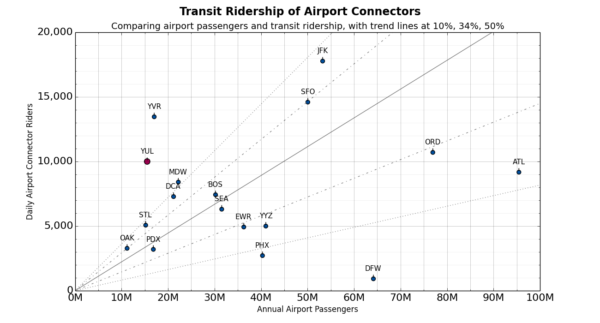
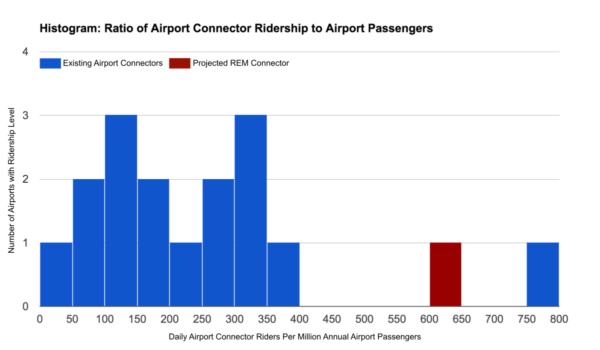
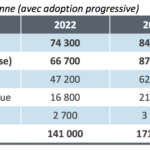
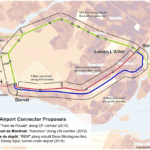
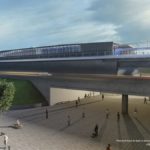
May 27th, 2016 at 04:23
I was just on the Toronto Union Pearson Express yesterday. They recently slashed the prices from $19 to $9 for those with a presto card (like opus) and ridership seemed way higher. Last time I was in there were like 3 other people. This time it was pretty full. Might be a price elasticity issue. Surprising because the old price was still cheaper than a taxi.
I haven’t seen revised ridership numbers after the price cut yet.
I also saw a handful of people get off before the airport. There are 3 other stops. They wanted to discourage commuting use but here we are.
May 27th, 2016 at 08:02
@plam
Well, we got that figure of 5000 riders now, up from the 2200 before, that I posted in the article. Commuting on the Airport Express is actually a _good_ thing. It’s the whole point of my article, that whatever transit line serves the airport should serve non-airport trips first.
May 27th, 2016 at 18:46
Consistent with price elasticity being important: Canada Line fares are low (and until a few months ago, were even lower). There is an airport surcharge but it’s only applied in one direction; the effective round trip fare is between $9.20 and $13, depending on time of day and fare instrument. That’s less (per direction) than Montreal’s airport bus.
Commuting use is a good thing unless it makes the trains uncomfortably crowded, but as you point out, the much more common problem is low ridership.
May 29th, 2016 at 16:54
@Joshua
Price is important — unfortunately we have very little information about the fare structure of REM, which is actually a big issue for the line as a whole. Pearson Express was sold with 20$ fares, but then they opened it with 27.50$. It was also sold as being profitable — they now have brought the ridership in line with (later) projections, but only by giving profitability all together.
June 13th, 2016 at 05:55
Newest UP numbers are 8,200/weekday, which brings the per-rider cost to $55k. At these numbers it may be reaching capacity, though. Felt that way when I was on it, but that was probably close to peak hours.
June 13th, 2016 at 08:22
@palm
That’s good news. Do you have a source?
It’s still an expensive project. And one does have to wonder how many of those new riders are actually not doing any trips related to the airport. That you say it was very full around peak hours may indicate that it’s people travelling between the few other stations. In my numbers, I tried to consider only the ridership of the airport connection itself.
For cost, also consider that a bunch of upgrades were done along the commuter rail corridor the UP runs. If you look at the Metrolinx annual reports, you’ll see hundreds of millions spent on that line to make it reader for improved service of the line and UP. Maybe we need some more numbers to evaluation this project better.
June 7th, 2017 at 16:01
Why such a big focus on the North American airport trains?
I understand that it helps compare, but at the same time it limits the re-imagining the airport train.
In other articles about the REM, you wrote about how VIA Rail wants to increase frequency and speed by building a new network for it. And with the Turcot project reserving tracks for passenger trains next to the new A20, Montreal has a unique chance to make things right.
Whether it will be AMT or VIA Rail (or both), we can build a better airport rail connection than what REM proposes and what the AeroTrain proposed a few years ago. If we’re lucky we maybe even get rid of the Lucien L’Allier station that is just so inefficient because trains have to turn around.
Call me a dreamer, but I’d like to see YUL get a rail tunnel like the one under Amsterdam’s Schiphol Airport (maybe not 6 lines, but 3 or 4 to be ready for future expansion).
It may split off around after Gare Valois. Pine Beach may be rendered useless though. After the stop at YUL, it can resurface around HW13 to reduce cost. Then create a new underground station at Montreal-West and from there reconnect with the to-be-built tracks on the new HW20 site. We’ll need to say goodbye to the tracks Lucien-L’Allier – Vendome – Montreal-West, but those have been splitting neighbourhoods up in two for decades (>century), which will surely benefit general traffic in Montreal West, NDG and the west of Ville-Marie.
After Turcot, St-Henri has always been a hell for motorists when trains come through. Courcelles and St-Ambroise crossings block off a lot of rush hour traffic daily.
At this point we should be inspired by the old train tracks to the first Bonaventure station (currently the Dow Planetarium stands on this site) and the Antwerp Central Station tunnel: if we create another tunnel, which roughly follows the old train tracks (Parc du Premier-Chemin-de-Fer), create a smart new transfer station at Lionel-Groulx, swing back under the 720 before it goes too deep, create a new station between the Bell Centre and the 720, platforms under De La Gauchetière to integrate a stop to Gare Central with a better transfer channels to the bus station and metro station. We can add another stop around the Palais de Congrès (maybe under the parking lot in front of the courthouse, with station facilities where they want to cover the 720). From there, going further east as an AMT LTR will offload some pressure from the green metro line and may even extend further.
As for VIA Rail, it will still want to connect to the current Gare Central infrastructure to be able to connect towards Laval for its new corridor to Quebec City. Updating all of this, including a great new rail infrastructure in Trois-Rivieres, may boost business for Dorval Airport, potentially attracting even move passengers from Quebec regions around Quebec City and Ottawa by being connected to an efficient rail service.